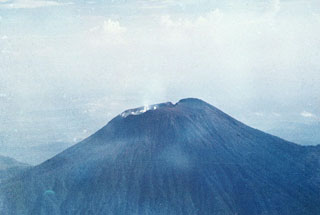Report on Slamet (Indonesia) — 30 April-6 May 2014
Smithsonian Institution / US Geological Survey
Weekly Volcanic Activity Report, 30 April-6 May 2014
Managing Editor: Sally Sennert.
Please cite this report as:
Global Volcanism Program, 2014. Report on Slamet (Indonesia) (Sennert, S, ed.). Weekly Volcanic Activity Report, 30 April-6 May 2014. Smithsonian Institution and US Geological Survey.
Slamet
Indonesia
7.242°S, 109.208°E; summit elev. 3428 m
All times are local (unless otherwise noted)
PVMBG reported that during 29 March-30 April seismicity at Slamet increased and inflation was detected. Observers noted that white plumes rose as high as 800 m above the crater, and dense gray ash plumes rose as high as 2 km and drifted E and W. During 19-25 April the plumes were gray to brown, and ejected material was deposited on the flanks 300 m from the crater. Crater incandescence was noted. During 26-30 April the ash plumes continued to have a brownish component, and material fell in areas within 1.5 km W. The crater was again incandescent. Rumbling noises were reported and windows at the Slamet observation post rattled during 27-29 April. The Alert Level was raised to 3 (on a scale of 1-4) on 30 April. Residents and tourists were warned not approach the crater within a radius of 4 km.
Geological Summary. Slamet is one of Java's most active volcanoes. It has a cluster of about three dozen cinder cones on its lower SE-NE flanks and a single cinder cone on the W flank. It is composed of two overlapping edifices, an older basaltic andesite to andesitic volcano on the west and a younger basaltic to basaltic andesite one on the east. Gunung Malang II cinder cone on the upper E flank on the younger edifice fed a lava flow that extends 6 km E. Four craters occur at the summit of Gunung Slamet, with activity migrating to the SW over time. Eruptions recorded since the 18th century have originated from a 150-m-deep, 450-m-wide, steep-walled crater at the western part of the summit and have consisted of explosive eruptions generally lasting a few days to a few weeks.
Source: Pusat Vulkanologi dan Mitigasi Bencana Geologi (PVMBG, also known as CVGHM)

